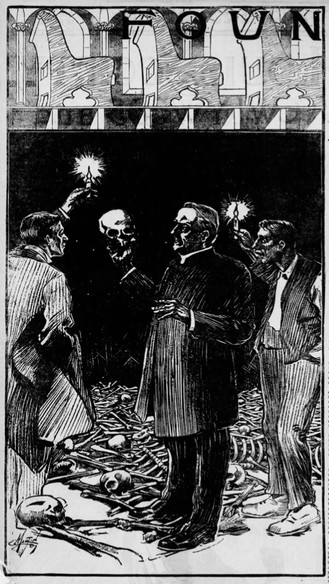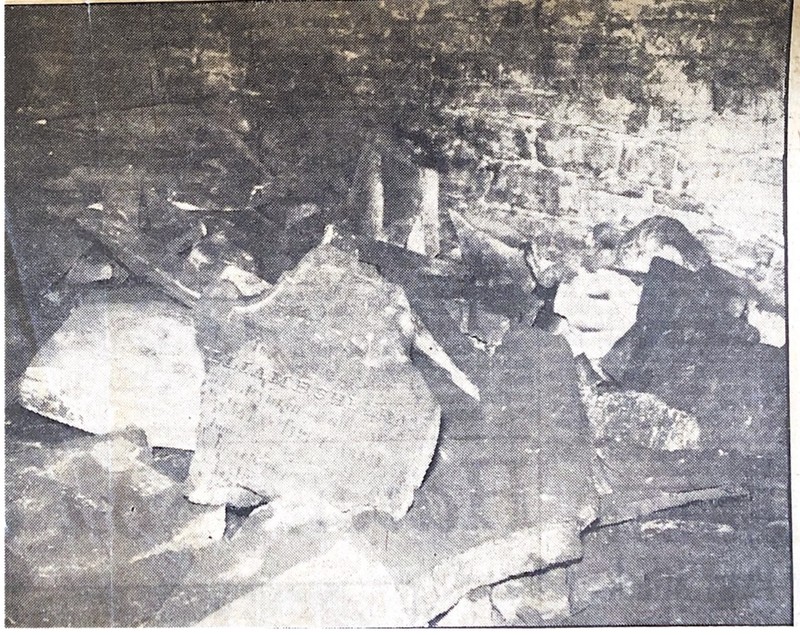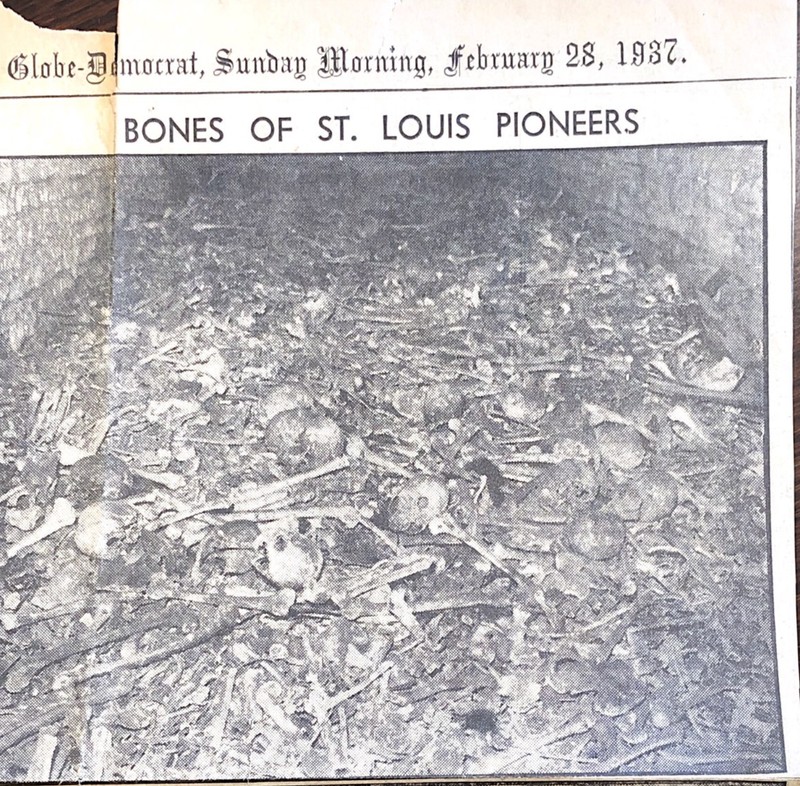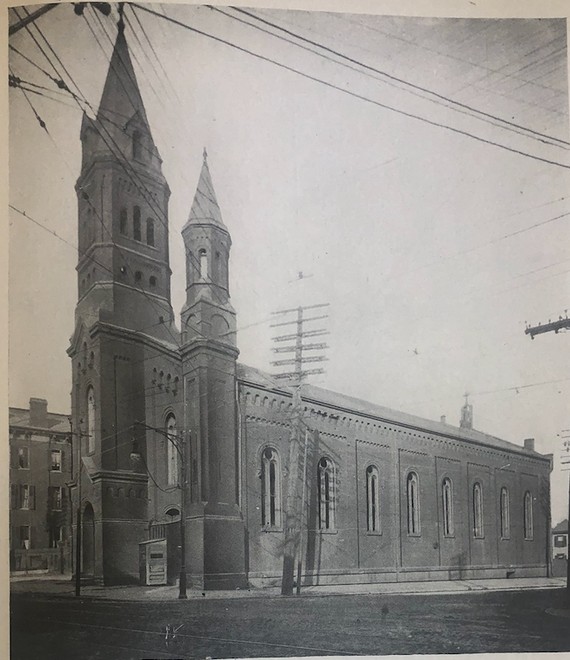St. Bridget of Erin
Introduction
Text-to-speech Audio
St. Bridget of Erin was built by the Irish community in an area known as Kerry Patch. The crypt at St. Bridget of Erin housed the remains of those whose families had moved out of the city or who were unidentifiable until the 1980s when they were relocated to Calvary Cemetery. St. Bridget of Erin was torn down in 2016.
Images
St. Louis Post Dispatch article with drawings of the crypt

St. Louis Post Dispatch article with photographs of the tombstones

St. Louis Post Dispatch article with photographs of the crypt

St. Louis Post Dispatch photograph of the outside of St. Bridget of Erin

Backstory and Context
Text-to-speech Audio
The Archdiocese of St. Louis was not spared from the changing St. Louis environment. Every time the city limits were expanded, they had to relocate graves. St. Bridget of Erin was built in 1859. The dirt floor basement would become a crypt to house the remains at Rock Springs Cemetery who were not identified or whose family was no longer in the area to help relocate them to Calvary Cemetery.
Some headstones were also piled up in the corner of the crypt, and in some spots, the headstones were used to pave the dirt floor of the crypt. Based on the headstones, those entombed at St. Bridget of Erin Crypt were of Irish, English, German, French, and African American descent.
The St. Louis Post Dispatch would describe the human remains in the crypt as glistening " in the candlelight, and the rows of teeth gleam at you." Both the drawing below and the photograph above show the human remains piled up in an unorganized way. It is unclear why this was done instead of grouping the bones.
As the definition of whiteness changed and Irish immigrants gained a white status in society, they moved out of Kerry Patch and abandoned St. Bridget of Erin. By the early 1900s, the community changed around St. Bridget of Erin to an African American community. One thing would stay the same regardless of demographics; St. Bridget of Erin was always a church for the poor.
The relocation of St. Bridget's crypt was handled in April of 1963 when the remains were placed into a mass grave at Calvary Cemetery. Reverend Shocklee and Reverend Hartnett handled the coordination of their relocation.
Sources
“25th Anniversary as Priest.” St. Louis Post-Dispatch, 21 June 1948, p. 15.
“A Church the Irish Built.” The St. Louis Star and Times, 5 June 1933, p. 4.
“Ask an Expert: Anne Austin Explores Historical Impact of Epidemics and Pandemics and Lessons for COVID-19.” UMSL Daily, 4 Mar. 2022, https://blogs.umsl.edu/news/2022/03/04/ask-an-expert-anne-austin-pandemics/.
Bingham, Helen. “A Clergyman’s Day...Rev. Marschner of St. Bridget’s.” Globe Democrat Magazine, 22 Jan. 1956, p. 36.
“Bishop Steck Praises Fr. Rider’s Labors.” St. Louis Globe Democrat, June 1948.
“---.” St. Louis Globe-Democrat, 21 June 1948, p. 3.
“Channel 9 Takes Viewers On Tour of St. Louis Houses of Worship.” St. Louis Post-Dispatch, 7 Dec. 1996, p. 27.
Conard, Howard Louis. Encyclopedia of the History of Missouri: A Compendium of History and Biography for Ready Reference. Southern History Company, 1901.
Dr. WM. G. Swekosky. 24 July 1955. Archdiocese of St. Louis.
Faherty, William Barnaby. “The St. Louis Irish: An Unmatched Celtic Community.” Missouri Historical Society Press, 2001.
“Fired For Refusing to Question Poverty Clients About Sex Lives.” The Daily Times, 10 May 1967, p. 24.
Flannery, Toni. “Other Near North Churches May Follow St. Patrick’s Demolition.” St. Louis Post Dispatch, 30 Dec. 1973, p. 37.
“FOUND! The Bones of First Settlers of St. Louis.” St. Louis Post-Dispatch, 24 Nov. 1907, p. 50.
Guide to St. Louis Catholic Archdiocesan Parish Records. St. Louis County Library, 2015.
Hartnett, James. Parish Correspondence- Burial Removal 1963. 10 Apr. 1963. St. Louis, MO: Archdiocesan Building Commission.
John A. Shocklee. Parish-Correspondence -Burial Removal 1963. 9 Apr. 1963.
O’Malley, Beth. “Rest in Peace, Unless the Cemetery Closes.” STLtoday.Com, https://www.stltoday.com/news/archives/rest-in-peace-unless-the-cemetery-closes/article_528e1351-7d71-528c-8bd3-03c4cac929bd.html. Accessed 18 Apr. 2022.
Pistor, Nicholas. “Preservation Debate out of the Dust.” St. Louis Post-Dispatch, Mar. 2016.
“Played in Death’s Chamber.” St. Louis Post Dispatch, Sept. 1897.
“Preservation Review Should Be Extended to All of City’s Wards.” St. Louis Post-Dispatch, 7 Mar. 2016, p. A08.
“Renovation Resources Often Lacking.” St. Louis Post-Dispatch, 6 Mar. 2016, p. B04.
“St. Bridget A Church the Irish Built.” The St. Louis Star and Times, June 1933.
“St. Bridget Parish Did Many Things for Neighborhood.” St. Louis Post-Dispatch, 28 Feb. 2016, p. A14.
“St. Bridget’s Church Marks 2 Anniversaries.” The St. Louis Star and Times, 21 June 1948, p. 9.
“St. Louis Church Built in 1859 Is Being Demolished.” St. Louis Post-Dispatch, 25 Feb. 2016, p. A04.
“St. Louis Genealogical Society.” St. Louis Genealogical Society, https://stlgs.org/amember/login. Accessed 18 Apr. 2022.
Stiritz, Mary M., et al. St. Louis: Historic Churches & Synagogues. MO: St. Louis Public Library, 1995.
“The People’s Priest.” The Riverfront Priest, vol. 295, 30 June 1984, p. 6.
“Vault of Catholic Church Holds Bones of St. Louis Pioneers.” St. Louis Globe-Democrat, 28 Feb. 1937, p. 9, https://www.newspapers.com/clip/100944511/vault-of-catholic-church-holds-bones-of/.
Weil, Andrew. Forgotten, But Not Gone: Retracing the Steps of St.Louis’OldestCemetery. 2019, https://doi.org/https://www.landmarks-stl.org/images/uploads/newsletters/Final%20Summer%20Newsletter%202019%20(3)-merged.pdf.
“Working the ‘Graveyard Shift’ at Ikea.” St. Louis Post-Dispatch, June 2014.
